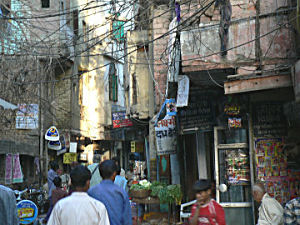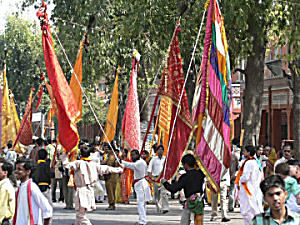
Arrival in Varanasi, the Mecca of Hinduism
Varanasi, in the northern state of Uttar Pradesh, was our major goal for this trip and we were met by friends at the airport, on our arrival from Delhi early in the day. Of course the plane was an hour late, which is the minimum delay for a plane arrival anywhere in India, or so it seems. Our friends greeted us with garlands of yellow and orange flower collars and we were first of all taken to a small, new temple where the spirit of a saint was going to descend upon the temple on that day.
Again, lots of friendly people; we were honored with flower collars once again, a round mark of orange powder was attached to our foreheads, and chairs were pulled up for us, the honored visitors from the West. We had to take our shoes off of course before stepping up into the small temple. Here we were greeted in the customary Indian way, joined palms in front of your chest, accompanied by a slight bow of the head. It is supposed to be a symbol of peace and the word of greeting is Namasté, in Sanskrit meaning ‘obeisance to you’, originally a sign of submission but in modern times rather implying a message of peace. In the weeks that followed we used this way of greeting whenever we were met by people we knew or to whom we were being introduced.
The festivities which had been going on for a week and which were now culminating in the descent of the spirit of the saint, represented by a statue in the back of the small temple, was celebrated by a crowd of people. They were mostly young people who were sitting cross-legged on the ground in front of a stage where music was being performed. Music seems to always go along with religious celebrations. Religion is accompanied by festive and happy people, masses of flowers, music and dancing. In many cases there are also floats, a multitude of colorful flags, festively decorated camels, horses and elephants and big brass bands.
 |
| Hindu religious procession in Jaipur |
Our friends, an Indian psychologist who is the founder of a center for mentally handicapped young people, the Deva Center, and a French psychotherapist who is the President of Deva Europe. After the inauguration of the temple, we were taken to this institution, met with some of the children and were flower-collared once again and orange powder was again applied to our foreheads, which is said to be a symbol for inner peace.
Varanasi, the Hindu most holy city
Kashi or Varanasi, the most sacred city in the Hindu religion, specifically dedicated to Shiva, the god of Destruction, but also the god of Fertility, the god who restores what he has destroyed. For a Hindu, traveling to Varanasi is considered the holiest of all pilgrimages. They come to Varanasi to wash away their sins in the holy water of the River Ganga and they go there to die.
Varanasi,
the sunrise over the holy river Ganga, the dirty and narrow alleys in
the oldest part of the city, the holy temples and shrines, the ghats
with the innumerable steps going down from the edge of the city all the
way into the water of Mother Ganga, where people worship at the edge of
the river or swim and play around farther out or where young boys wash
holy buffaloes in an area set aside for this purpose. Women step into
the water fully dressed in their saris, but men and children change
into something more or less approaching nakedness.
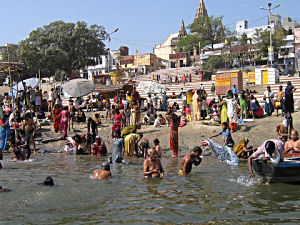 |
|
Bathers praying and swimming in the holy river Ganga at the foot of the Ghats |
Varanasi, the crowded streets lined with bazaars that open directly onto the street, the vivid colors, the hustle and bustle in the streets crowded with people, rickshaws, bicycles, scooters, cars, dogs, holy cows and goats. This is the most incredible city of Varanasi, the holiest city in the Hindu religion.
There are lepers and beggars along the river and in the bustling streets. There is an intensity of color, movement and noise in this most amazing of cities that can not be equaled in any place I have ever known on earth. It is a city you will never forget after you have gotten to know it once.
Everywhere there is intense life filled with bright colors, deafening noise, constant movement, smells of cooking, incense and dirt. You see lively people with sparkling eyes, dogs lying exhausted and abandoned in the streets, herds of goats walking around leisurely and unattended and holy cows that are deferentially left alone even when they lie down in the middle of a narrow alley. On the big roads in the cities and in the countryside, you usually see the cows close to the mid-strip or on the side of the road alongside the open bazaars, calmly ruminating or asleep amid the noise and the unceasing movement around them. There are dogs and children running around everywhere, children begging, children selling flowers and candles in shallow cups to be put on the river at dawn as an offering to Mother Ganga, an ancient Hindu ceremony, a prayer that is sent out over the holy river.
On
our first morning in Varanasi, we got up before dawn to get a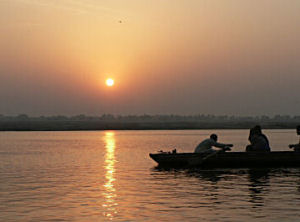 boat ride
down the Ganga, which means going north in this case since the river
makes an s-curve. As soon as we got down to Asi Ghat, close to our
hotel, there was a multitude of young men who were all eager to offer
us a ride as far up as we would like to go. We all had the ritual
candle in the shallow cup and as we watched the sun rise in the east
over the flat land on the other side of the river, we set the candles
afloat on the water and saw them drifting away. It was a moving ritual
even for us ‘impure’ Westerners. The sun lit up the
facades on the west
side of the river, the whole range of ghats and the house fronts, some
of them former palaces, some temples and a great variety of buildings, some run-down some in good shape.
boat ride
down the Ganga, which means going north in this case since the river
makes an s-curve. As soon as we got down to Asi Ghat, close to our
hotel, there was a multitude of young men who were all eager to offer
us a ride as far up as we would like to go. We all had the ritual
candle in the shallow cup and as we watched the sun rise in the east
over the flat land on the other side of the river, we set the candles
afloat on the water and saw them drifting away. It was a moving ritual
even for us ‘impure’ Westerners. The sun lit up the
facades on the west
side of the river, the whole range of ghats and the house fronts, some
of them former palaces, some temples and a great variety of buildings, some run-down some in good shape.
We got off the boat midways up along the city and walked up the steps at the Dashashvamedh Ghat to what is called the Crossing, along the street that is the center of trading in downtown Varanasi. We passed by lepers and beggars sitting and lying along a banister in the middle of the ghat going up to the shopping section of the town. The contrasts are pretty grim.
The women are dressed in colorful saris and the men mostly in western clothing, a good number though wearing the Kurta and Pajama that is the typically Hindu garb, or the Muslims in soberly white suits, always impeccably spotless and unwrinkled. The relatively few Muslim women we saw in Varanasi seemed to be all dressed in black burkas. But we didn’t see the slightest trace of religious tension. People went about their business as if there was no such thing as hostility between religions in the world.
Buying and selling is always going on, colorful saris on both sides of the business deal. The bazaars display everything imaginable from textiles and sandals, to candy to kitchen utensils and electronic apparel, to postcards and colorful flower collars.
Varanasi is the holiest Hindu city, not just in the state of Uttar Pradesh but in all of India. Old people come to this holy city on a pilgrimage to spend the last of their days here and, after they die, for their ashes to be cast over the holy river Ganga. Thereby they will attain Moksha, Salvation or liberation from reincarnation. In Sanskrit, the origin of Hindi which is the major language in northern India, Moksha means "liberation from earthly bondage".
You see old women laboring up the steep multitude of steps on the ghats along the river, after an ablution in the holy Ganga, maybe going to one of the many shrines along the narrow streets in the old part of the city. People fill their little silver or brass pots with holy water from the Ganga which they carry away with them to pour over a holy object as an offering.
In the old city of northern Varanasi there is the famous Kashi-Vishvanath temple, the Golden Temple, dating from 1000 years ago, dedicated to Lord Shiva, the most impressive temple in this holiest of Hindu cities. About one hundred years ago king Ranjit Singh had the Kashi Vishvanath temple towers covered in gold and it is a temple of magic splendor, which, however, we never got to see.
The day of Shivaratri, the greatest festival of the year, which usually occurs towards the end of February, we were walking through the old northern part of Varanasi. The name Shivaratri means "the night of Shiva" and the ceremonies take place chiefly at night. This is a festival observed in honor of Lord Shiva who was married to Parvati on this day.
We were trying to find our way to the Golden Temple, winding through the narrow streets of the old city. As we finally approached the temple, we saw lines kilometers long, from two directions, leading up to Kashi-Vishvanath. There seemed to be little hope of our getting to see the temple and everybody kept telling us that we were not Hindus and so we were not allowed into the temple. Police officers told us to walk around the big block and we would be able to see it from the eastern side. So we did, and we still didn’t get to see anything but young men with postcards of the temple who tried to get us to follow them through an entrance where we would see the temple. Or so they said. Luckily, we didn’t believe the young postcard-peddling tricksters and we never got to see the famous golden temple – just on postcards.
Countryside roads and streets
The streets in India are an experience in themselves. An incredible throng of auto and bicycle rickshaws, scooters, bicycles, animals of all kinds compete with colorfully dressed pedestrians, the Hindu women always in their colorful saris, children mostly in western clothes, except for the neatly uniformed youngsters on their way to and from school, the boys, often on bikes, wearing ties, the girls usually in groups walking along the sides of the countryside roads.
And let us not forget the holy cows and buffaloes that line the sides and the mid-strips of the roads. Some roads, such as from Jaipur to Delhi are 4-lane highways in pretty good shape, but most roads are in terribly bad repair, even though there seemed to be constant working going on for road improvement. This heavy work was often done by Dalit women (the untouchables, the outcastes) who are seen carrying heavy loads of stones and sand on their heads and by men and women who were repairing or building mid-strips on the major roads without any electrical tools, basically working with their hands and primitive hand-held tools. Rickshaws, cars and scooters honk constantly, to alert pedestrians and to pass other vehicles, right or left, whatever suits the situation. The noise is constant but you soon get so used to it that you no longer pay attention to it.
Heavy loads are
pulled on the major roads by anything from rickshaws to dilapidated
trucks to horses and, above all, by camels.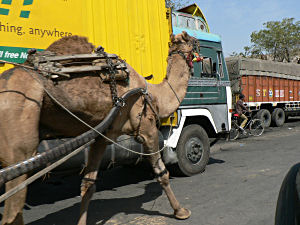
The cities we got to know varied enormously in looks and layouts. There is Varanasi in Uttar Pradesh, which was the very old type of city, with its narrow streets, the infinite bazaars, ruminating cows in the streets and the holy shrines. In fact, the streets were so narrow in the old part of the city that no motor traffic was even possible.
Khajuraho in Madhya Pradesh
There are cities like Khajuraho in Madhya Pradesh with the famous old temples, where there is practically just one major road and innumerable bicycle and auto-rickshaws and young men who pounce on you as soon as you get out in the street, asking to take you to wherever you choose to go. The price has to be agreed on beforehand or you are sure to get ripped off. You always bargain. It is expected and it is just the way things are done in India.
Today in Khajuraho there are 25 temples left out of what was once an enormous assemblage of 85 temples built between 900 and 1050 AD by the kings of the Chandala dynasty. They are dedicated to the trinity of Brahma, Vishnu and Shiva and to other incarnations of those gods. The temples are spread over a surface of eight square miles and you do well to hire a rickshaw to get to the eastern and southern groups of temples.
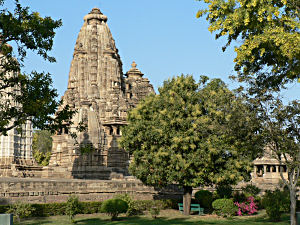
The largest group is in the Western park of temples right across from the business part in the center of the city. The temples in Khajuraho have been chosen as a United Nations World Heritage Center. The huge park around the western group is a marvel of well-kept lawns, flowering bushes – enormous groups of bougainvillea, oleander, rosebushes and other to us unknown kinds of flowers and bushes.
Jaipur in Rajasthan
A very different kind of city is Jaipur in Rajasthan, west of Uttar Pradesh, with its population of 3 million, of whom one quarter live in shantytowns on the outskirts of the city and of these 90% are analphabets. The Dalit population in all of India represent an
enormous load of guilt in what is otherwise considered a great democracy and a country in economic progress. Jaipur is a major tourism center with its pink city within the old city gates and walls. In 1876, Maharajah Ram Singh had the old city painted pink and it has still kept its nickname to this day. Apart from the old city within the gates and its City Palace, the palace of the Maharajah of Jaipur, it is also a city with numerous outlets for buying – everything from textiles and rugs to jewelry and small-size Indian sculptures.
 There
is as well a breathtakingly beautiful palace about 10 kilometers
outside the city, called Amber Fort. A
wall which recalls the Great Wall of China surrounds practically the
whole area, following the crest of the low mountains that go
around the
fort, which was built in a bowl-shaped depression. You can be carried
up the hill to the fort on the back of an elephant if you get there
early in the morning. Later in the day, the elephants are all cooling
of in a pond at the bottom of the hill and you have to rent a jeep to
get into the fort. It was great fun seeing the elephants getting washed
and attended to by the young men who are hired to take care of them and
to see them shower themselves with cascades of water from the pond.
There
is as well a breathtakingly beautiful palace about 10 kilometers
outside the city, called Amber Fort. A
wall which recalls the Great Wall of China surrounds practically the
whole area, following the crest of the low mountains that go
around the
fort, which was built in a bowl-shaped depression. You can be carried
up the hill to the fort on the back of an elephant if you get there
early in the morning. Later in the day, the elephants are all cooling
of in a pond at the bottom of the hill and you have to rent a jeep to
get into the fort. It was great fun seeing the elephants getting washed
and attended to by the young men who are hired to take care of them and
to see them shower themselves with cascades of water from the pond.
Some of the elephants have colorfully tattooed heads and when they take part in religious processions, they are usually decorated all over their legs as well, their backs covered with decorative covers, as are the camels and horses. And religious processions take place all the time, for any number of reasons it seems, sometimes a wedding, sometimes a Hindu holy day. In Varanasi there are minor processions of the dead being carried down by Dalit men to the Ganga to be burned during the night so their ashes can be cast over the holy Ganga and the soul of the dead person will attain Moksha, Salvation or liberation from reincarnation.
|
|
Jama Masjid, the Great Mosque inOld Delhi |
